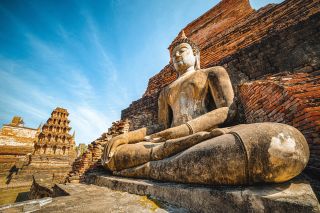Philosophy
Why Your Ego Is an Illusion
The Buddhist take on the self.
Updated May 6, 2024 Reviewed by Jessica Schrader
Key points
- In Buddhist thought, the self is said both to exist and not to exist.
- This “not-self” is composed of five elements, or skandhas, that are in a constant state of flux.
- Together, the five skandhas create for the not-self the illusion of integrity and continuity.

In my previous post, I discussed the Buddha’s solution to suffering: the Middle Way, Four Noble Truths, and Eightfold Path.
Two early insights that led the Buddha to enlightenment are the Middle Way and Dependent Origination. According to the doctrine of the Middle Way, we are more likely to achieve insight and wisdom if we avoid extremes of self-gratification and self-mortification.
According to the doctrine of Dependent Origination, or Interdependent Arising, life is a continuous process of change, and every instance of change has manifold causes and effects. This means that all things are conditioned by other things, and that all things are interconnected. Suffering arises from a craving for permanence; but all permanence is an illusion that, in time, can only lead to pain and disappointment.
Although nothing exists permanently, it is equally wrong to say that nothing exists at all. This, too, is a middle way. Does the self exist? In a sense it does; in another sense it does not—which is why, when asked the question, the Buddha, as was his way, simply remained silent.
Nagarjuna on Emptiness
The Middle Way and Dependent Origination pervade all aspects of Buddhist thought. After the Buddha, the most noted Buddhist philosopher is Nagarjuna (d. c. 250 CE), who founded or re-founded the Madhyamaka (“Middle Way”) school, an important strand of Mahayana (Great Vehicle) Buddhism. In the Root Verses on the Middle Way, Nagarjuna argues that between the extremes of permanence and nothingness lies emptiness, or shunyata. Although they exist, all phenomena are “empty” insofar as they lack permanence and autonomous existence.
Although this sounds pessimistic—and Nagarjuna has been accused of being a nihilist—it is precisely this emptiness and fluidity that underlies the possibility of change and creation. In Zen Buddhism, a more dynamic alternative to the koan, or riddle, is for the master to suddenly slap his student to shake him out of who he thinks he is and what he thinks he’s doing. This, however, would not be legal today.
The Not-Self
How is it that the self can both exist and not exist?
The self, or “not-self” (anatta), is composed of five elements (skandhas), namely, body, sensation, perception, will, and consciousness. The five skandhas are in a constant state of flux but together create for the not-self the illusion of integrity and continuity, that is, the illusion of the self.
This explains why, when I try to become aware of myself, I can only ever become aware of such and such perception, such and such sensation, or such and such thought, but never of any actual, core self.
Try it now for “yourself”…
Rebirth and Release
The death of the bodily self leads to the disaggregation of the skandhas and to their re-aggregation into another not-self, which is neither identical to nor entirely different from the previous one, but forms part of a causal continuum with it. An analogy that is often offered to describe this process of rebirth is that of a flame, fuelled by desire, passing from one candle to the next.
The cycle of rebirth can only be broken if the self is able to transcend its subjective and distorted image of the world, which is built around the “I am” conceit. This, then, is nibbana, or, in Sanskrit, nirvana. Nirvana, as I see it, rests on the understanding that consciousness is a sequence of conscious moments rather than the continuous, unbroken consciousness of the “I am” conceit.
Western Parallels
If this all sounds rather mystical, consider that the empiricist philosopher David Hume (d. 1776) independently arrived at a similar view:
…when I enter most intimately into what I call myself, I always stumble on some particular perception or other, of heat or cold, light or shade, love or hatred, pain or pleasure. I can never catch myself at any time without a perception, and never can observe anything but the perception. When my perceptions are removed for a time, as by sound sleep, so long am I insensible to myself, and may truly be said not to exist.
This is taken from Hume's Treatise of Human Nature.
Implications
Our ego defences as broadly conceived—that is, not only our ego defences proper but also our habits, customs, culture, and other ties—may provide us with an illusion of self, but they also define us as such and such, and, in so doing, constrain our range of thought, feeling, and action. Paradoxically, the very elements that furnish us with our sense of self are also those that prevent us from fulfilling our true promise and potential as human beings.
As I argue in my book on the psychology of self-deception, it is only by renouncing the self, that is, by dropping her defences and committing symbolic suicide, that a person is able to open up to different modes of being and relating and transform herself into a pure essence of humanity. In so doing, she becomes free to recast herself as a more joyful and productive person, and attains the only species of transcendence and immortality that is open to us, mere mortals.
And so, if we are to live, we must first learn to die.
Neel Burton is author of Indian Mythology and Philosophy.
References
David Hume, A Treatise of Human Nature, 1.4.6.




